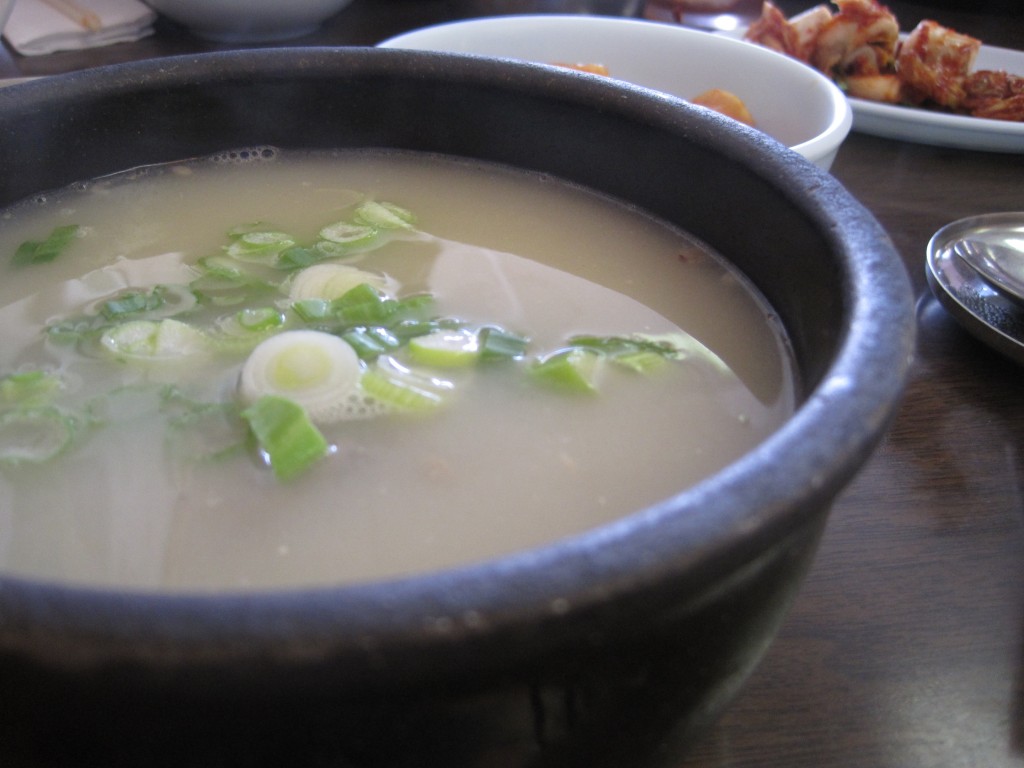
Young & Hungry: Seolleongtang from Han Bat

Happy Memorial Day everyone. I’m turning over the blog today – as I do on occasion – to star intern Katherine Bernot, a senior at Northwestern. Her occasional series, “Young and Hungry” profiles joints around Chicago where she and her friends can eat well for about $10 a person.
At Han Bat, less is more. This unassuming Korean restaurant in Lincoln Square serves a simple ox bone soup and not much else. The milky white broth, called seolleongtang, might at first seem too basic to build a whole business around, but this soup at Han Bat is minimalist perfection.
The menu posted on the wall at Han Bat is mostly in Korean, but a few English words indicate the meat choices that can be added to the ox bone soup: brisket, tripe, tendon and flank steak. The only other addition to the broth is a choice of dang-myun (clear noodles made from sweet potato starch) or gook-su (rice noodles). A soup of just broth, meat and noodles doesn’t taste like much at first, so the do-it-yourself seasonings are key. I added green onions, rice, some spicy chili, sauce from the kimchee and salt. Lots and lots of salt. An entire bowl of rock salt on the table may seem unnecessary, but the light, mineral taste of the soup demands it.
After properly seasoning my soup, I began alternately slurping it by the spoonful and using my chopsticks to pick out the tender, juicy brisket and chewy clear noodles and rice. The best word to describe seolleongtang is ‘comforting’, which may be why some people tout it as a hangover cure. The warm simplicity of the broth is achieved by cooking the ox bones for hours until the flavor gradually seeps out. Seolleongtang’s flavor is subtle, growing on you rather than surprising you. I didn’t realize how quickly I was downing my bowl until my spoon rattled at the empty bottom.

Our server, who only spoke Korean, refilled our barley tea frequently, which is served slightly cool. Like the broth, the tea has a relatively bland but intriguing taste that settles the stomach. The boldest part of the meal are the side dishes of pickled radishes and kimchee (fermented cabbage). The kimchee, cut table-side, is solid, but is outshined by the pickled daikon radishes. These spicy, crunchy cubes provide the kick that the meal needs and provide a burst of spice between spoonfuls of soup.
Sitting back in my chair after the meal, I found myself much more relaxed than when my friends and I arrived at Han Bat. While most inexpensive food involves a rushed, loud cafeteria-style ordering process that leaves diners feeling more stressed than satisfied, my $8 lunch at Han Bat had the opposite effect. Korean food is genuinely associated with barbecue, but it’s definitely worth the trip to Han Bat to experience the more subtle side of Korean cuisine.
Han Bat, 2723 W. Lawrence Avenue, (773) 271-8640
